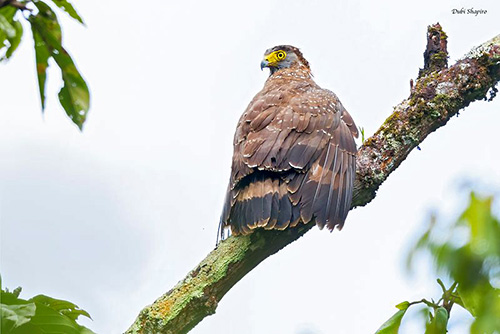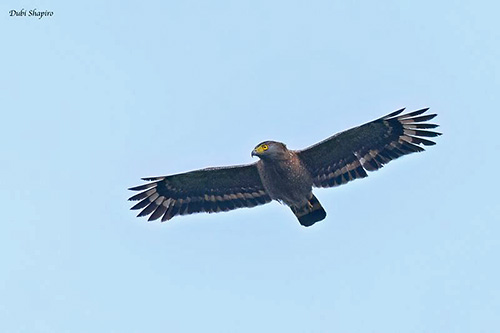
REPRODUCTION OF THIS SPECIES:
The breeding season takes place during the dry months.
The Philippine Serpent Eagle builds a platform with sticks, twigs and leaves among the foliage of tall tree, usually in undisturbed forest area.
The female lays one or two eggs, and she incubates during about 40 days. During this period, she is fed by the male which hunts regularly and protects the nest-site.
At hatching, the chicks are covered in white down. They are altricial, and both parents take turn to care for and feed them.
As usual in raptors, the young birds grow quickly. They are fed and protected by both adults during two months, before to be ready to fly.
PROTECTION / THREATS / STATUS:
The Philippine Serpent Eagle is affected by habitat loss caused by deforestation and human presence.
This species plays an important role by helping to control populations of reptiles and small mammals. It needs conservation efforts to secure the habitat. But the species is able to adapt to open and second growths. In addition, it is found in several natural parks and protected areas.
The size of the population is unknown, but it is suspected to be decreasing.
However, the Philippine Serpent Eagle is currently evaluated as Least Concern.
Fr: Serpentaire des Philippines
Ang: Philippine Serpent-Eagle
All: Philippinenschlangenadler
Esp: Culebrera Filipina
Ita: Serpentario delle Filippine
Nd: Filipijnse Slangenarend
Sd: filippinsk hjälmörn
Photographer:
Dubi Shapiro
Dubi Shapiro Photo Galleries
Text by Nicole Bouglouan
Sources:
HANDBOOK OF THE BIRDS OF THE WORLD Vol 2 by Josep del Hoyo-Andrew Elliot-Jordi Sargatal - Lynx Edicions - ISBN: 8487334156
A photographic guide to Birds of the Philippines by Tim Fisher and Nigel Hicks. New Holland Publishers. ISBN: 9781847738301
Department of Environment and Natural Resources
Wikipedia, the free encyclopaedia
Snake-Eagles, Serpent-Eagles and Bateleur
Philippine Serpent-Eagle
Spilornis holospilus
Accipitriformes Order – Accipitridae Family
INTRODUCTION:
The Philippine Serpent Eagle is endemic to the Philippines, where it frequents both primary and secondary forests on some islands, especially Luzon Island and Mindanao Island, and several smaller islands.
It feeds on a variety of snakes and lizards, and also takes insects and small vertebrates such as rodents. It usually hunts in forested areas where it can find good food resources.
During the breeding season, both mates perform aerial displays, diving and then, circling each other. They are monogamous with strong pair-bonds. The stick nest is built in tall tree among the foliage, within the forest. Both parents share the nesting duties.
The Philippine Serpent Eagle is described as fairly common. The species is able to adapt to open and secondary habitats, and despite deforestation throughout the range, this raptor is not globally threatened at the moment.
DESCRIPTION OF THE BIRD:
Biometrics:
Length: 47-53 cm
Wingspan: 105-120 cm
Weight: M: 603-672 gr – F: 691-1,200 gr
The Philippine Serpent Eagle is a medium-sized raptor, with wide wings and long tail.
It resembles Crested Serpent Eagle, with the same broad, whitish band in tail and across flight-feathers.
The Philippine Serpent Eagle adult male has brown plumage overall, with pale spots and markings visible both on body and wings.
On the wings, the primary feathers are black, with white spots along the wing-coverts.
The tail is black with pale central band and secondary basal band. The rectrices have narrow, whitish tips.
The underparts may appear more rufous-brown and uniformly coloured, with spots and markings usually clearly defined.

The head is brown with a prominent, short, bushy crest. The crown is brown, whereas cheeks and throat are grey to grey-brown.
The hooked bill is black with yellowish cere.
The eyes are yellow, sharp and piercing, providing very good vision while the bird is hunting. Both eyering and lores are yellow.
Legs and feet are yellow with black talons. They are robust, well adapted for capturing prey.
The female has very similar appearance, but she is 6 to 16% larger than male.
The juvenile differs from adults in coloration, showing a less defined appearance. The body plumage is paler, showing more mottled pattern with paler browns, and rufous to buff edges to feathers.
On the upperparts, the mantle is streaked and spotted with brown. Along the wing-coverts, the feathers are white at the base. The tail is dark brown with pale tip and three brown bands.
On the underparts, the plumage is cream to white, showing rufous markings along the breast, and paler rufous streaking along belly and thighs.
On the head, the crown is white, and there are two dark patches behind the eyes. The crest is less pronounced. The eyes are duller, mostly grey.
As the young bird reaches maturity, the typical sharpness found in mature eagles develops progressively.
RANGE:
The Philippine Serpent Eagle is endemic to the Philippines. It occurs on the islands of Luzon, Leyte, Samar, Mindanao, and on several smaller islands, excluding the W islands from the Calamianes S to Balabac.

HABITAT:
The Philippine Serpent Eagle frequents lowland forests and wooded areas. It is usually found in tropical moist forest, montane forest, secondary growth and cultivated areas with scattered trees.
It is able to adapt to human-modified habitats.
The species is visible up to 2,500 metres of elevation above the sea-level.
CRIS ET CHANTS: SOUNDS BY XENO-CANTO
The Philippine Serpent Eagle becomes more vocal while displaying to attract a female. It calls while soaring during the aerial displays.
While defending the territory, it gives distinctive loud whistling calls, and it is often considered as a “vocal forest sentinel”.
It is described as “fairly noisy” and often calls when perched. The common call is a series of whistles, followed by “pheeeeuw – pheeeeuw”. This call is also given in flight “weeeeeuuuuu weu weu” but also sometimes as a single note.
They produce series of high-pitched whistles to communicate, and these shrill whistles are often heard through the dense forests.
BEHAVIOUR IN THE WILD:
The Philippine Serpent Eagle feeds primarily on snakes and lizards, but amphibians, insects and small mammals are also part of the diet.
It hunts by soaring at moderate elevations or by circling high in the canopy while looking for prey, using its well-adapted eyesight to detect prey, both in flight and from perches.
Amphibians are mainly taken during the wet season, and the diet varies depending on prey availability. This species usually hunts in forested areas providing abundant food resources.

At the beginning of the breeding season, the Philippine Serpent Eagle performs aerial displays to attract a female, soaring and calling in the air.
During the breeding season, both mates can be seen flying together, diving and circling each other. These displays allow the birds to establish a strong bond. They are monogamous.
This species nests in tall trees among the foliage, often in undisturbed forest areas.
Both adults share the nesting duties.
The Philippine Serpent Eagle is largely sedentary throughout the range.
The Philippine Serpent Eagle shows impressive soaring abilities, allowing it to conserve energy. It soars high above the forest after thermals develop. It often soars throughout the day.
The flight enhances the wide wings of this species. We can also see a distinctive white band along the trailing edge and near the end of the tail.
